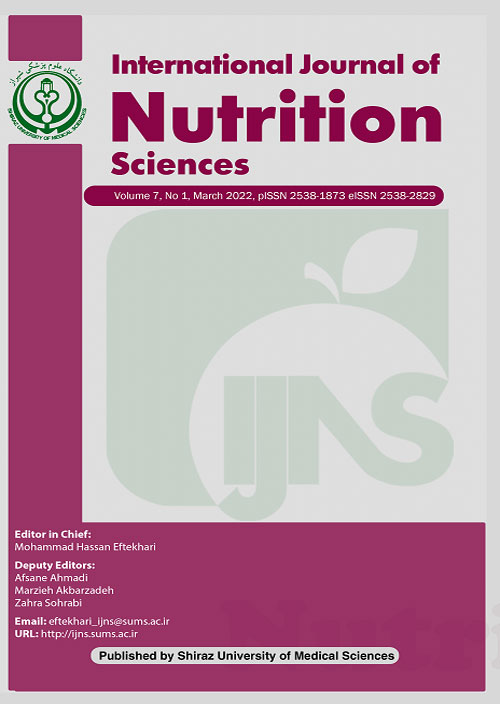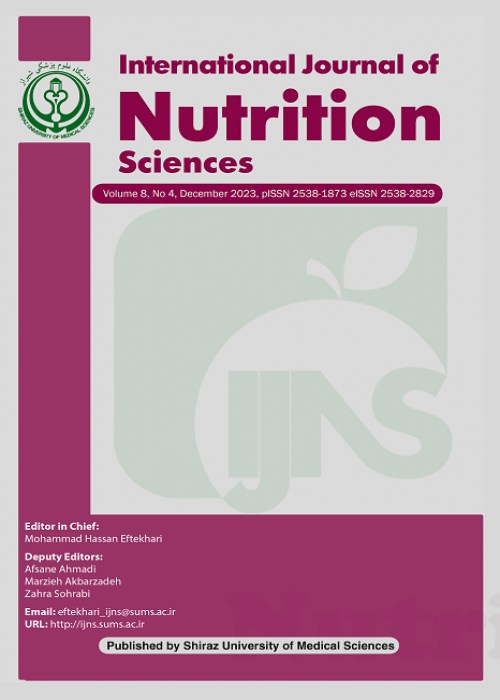فهرست مطالب

International Journal of Nutrition Sciences
Volume:7 Issue: 3, Sep 2022
- تاریخ انتشار: 1401/08/15
- تعداد عناوین: 8
-
-
Pages 125-130
Overweight and obesity are the causes of many diseases. One of the most important and modifiable factors in obesity is dietary changes. Fats are macronutrients that provide more calories than proteins and carbohydrates; therefore, they are blamed for the accumulation of fat mass in the body. Different types of fatty acids have been shown to have different metabolic responses. There is no definite consensus on the effect of different types of fatty acids on body composition, but a review of the literature shows that different fatty acids have important differences in accumulation of adipose tissue. Monounsaturated fatty acid (MUFA) levels of more than 12% of calories in weight loss diets have been significantly associated with further reduction of adipose tissue. Higher blood levels of alpha linolenic acid (n-3) and gamma linoleic acid were inversely associated with weight gain. There is a significant inverse relationship between PUFA/SFA and MUFA/SFA levels and waist circumference and consity index. Methylation of adiponectin gene is altered by overuse of saturated fatty acids (SFAs). SFAs and trans fatty acids (TFAs) have lower oxidation rates than polyunsaturated fatty acids (PUFAs) and MUFAs. This feature makes them more inclined to save. Replacing SFA and TFA with MUFA and PUFA can reduce the accumulation of adipose tissue and maintain more lean body mass. Although it is recommended that about 30% of dietary calories to be obtained from fats, the exact share of each of these fatty acids in diet to achieve the desired results has not been determined, yet.
Keywords: Adipose tissue, Dietary fatty acids, Body fat -
Pages 131-137Background
Obesity is a public health and various methods are used to manage this health issue. The aim of this review was to investigate the possible effects of Chromium supplementation on body composition and body weight.
MethodsDatabases such as PubMed, EMBASE, The Cochrane Library, Scopus, and Web of Science were searched for human studies in English using keywords of body weight, body mass index (BMI), fat mass, adipose tissue, total body fat, obesity, overweight, ideal body weight, weight loss, weight reduction, and chromium supplementation.
ResultsTotally, 345 articles were enrolled. The effect of 400 mcg/day intervention was more pronounced when compared to 200 mcg/day. Later, in 1998, the role of physical activity was illustrated and as a result, a significant change in body composition was seen. Volpe et al. found a slight relationship between 400 mcg/day of chromium supplementation and decrease in body fat mass (mean=1.78%/max=7.54%). Liu et al. reported no significant changes in BMI, fat mass, and fat-free mass. Moreover, Yazaki et al. investigated the effect of 1000 mcg supplementation. Still, no change was seen in BMI neither in the first 12 weeks nor whole 24 weeks of the study. It might have slightly positive effects on decreasing body fat and increasing lean body mass.
ConclusionThe undertaken studies mostly showed better and stronger results for the effect of chromium supplementation on body weight or fat mass when physical activity was included or higher doses were consumed.
Keywords: Chromium, Adipose tissue, Body weight, Body fat, Obesity -
Pages 138-146BackgroundBased on high transmissibility of coronavirus disease-19 (COVID-19), nationwide lockdowns were undertaken to halt the spread of virus associated with changes in snack behavior. This study aimed to observe changes in snack behavior in Sri Lankan adults.MethodsThis cross-sectional study was conducted from 27th May to 02nd June 2021. A pre-tested, self-administered questionnaire was shared via online social networking platforms using Google forms.ResultsTotally, 3601 respondents participated in the study, of which 60.1% were females, and 82.1% were Sinhalese. The majority of the respondentsincreased consumption of coffee/tea (53.7%), and biscuit (42.3%); where asubstantial proportion reported decreased consumption of cake (49.8%), sweets (49.0%), snacks (47.5%), desserts (46.2%), and sugar-sweetened beverages (48.7%). Participants of 31-35 years age (OR=1.445; 95% CI:1.119-1.865, p=0.005) and 36-40 years age (OR=1.409; 95% CI: 1.065- 1.864, p=0.016) reported the significantly higher biscuit consumption. Respondents in 31-35 years age (OR=1.265; 95% CI: 1.004 to 1.592, p=0.046) significantly increased coffee/tea intake. Among ethnic groups, Sinhalese (OR=1.509; 95% CI: 1.164 to 1.955, p=0.002) and Tamils (OR=1.408; 95% CI: 1.007 to 1.969, p=0.045) showed significant odds to increased coffee/tea drinking pattern. The respondents with monthly family income levels of less than 200,000 LKR (1000 USD) significantly liked to report increased consumption of biscuits and coffee/tea.ConclusionCOVID-19 lockdown impacted snack consumption behavior among Sri Lankan adults. The consumption of coffee/tea and biscuit increased too.Keywords: Biscuit, COVID-19, Dietary behaviour, Snack consumption, Sri Lanka
-
Pages 147-154BackgroundRecovery rate of children with severe acute malnutrition can be affected by several factors. The study accentuated on identifying recovery rate and its predictors in treatment of children with severe acute malnutrition using Outpatient Therapeutic Feeding Program in Shalla Health District, South West Ethiopia.MethodsInstitutional based retrospective cohort study design was employed. A record of 1004 was collected and analyzed. Kaplan Meier procedure, Log rank test and multiple variable cox proportional hazard regression were used in order to test the significant relationship between recovery rate and independent factors.ResultsThe finding of the study revealed that 90.9% of children recovered with a median recovery time of 45 days with an interquartile range (IQR) from 5 to 7 weeks. The recovery rate among those who received amoxicillin was 5.86 (Adjusted Hazard Ratio (AHR)=5.86, 95% CI: 4.55-7.55) times higher than those who did not receive. Additionally, the finding of the study showed that the recovery rate of children who had diarrhea was 49% (AHR=0.51, 95% CI: 0.44-0.59), vomiting was 61% (AHR=0.39, 95% CI: 0.33-0.46), and among those who were admittedwith edema was 30% (AHR=0.70, 95% CI: 0.58-0.84) that were less likely than those admitted without edema.ConclusionIt was identified that medication with amoxicillin was taken as a predicator that positively affected the time to recover. But; diarrhea, vomiting and edema were recognized as factors affecting recovery time negatively. Thus, early identification and management of diarrhea, vomiting and edema as well as regular management of cases with antibiotics is recommended to improve recovery rate.Keywords: Recovery rate, Outpatient treatment feeding program, Malnutrition, Ethiopia
-
Pages 155-161Background
A premature birth is a life threatening situation that causes an increase in infant death. The aim of the present study was to investigate the contributing factors to the weight gain process in premature infants in the Neonatal Intensive Care Unit (NICU).
MethodsThe present birth cohort study was performed on 47 premature infants born in Hafez Hospital in Shiraz, Iran from July 2019 to February 2020. Infants born before the 37th gestational week, who were hospitalized for at least 7 days were included in the study. Demographic and anthropometric data, feeding conditions and supplements, durations of hospitalization, and nothing by mouth (NPO) state, before breastfeeding,and before initiation of oral feeding were recorded.
ResultsTwenty eight (59.57%) boys and nineteen (40.42%) girls (n=47) with median of 13 days hospitalization were enrolled. Intakes of amino acid solution (p<0.001), lipid emulsion (p=0.04), phosphorus (p=0.01), and folic acid (p=0.02) were correlated with weight gain process. Results showed a significant linear correlation between hospitalization duration (p<0.001), NPO duration (p=0.02), and duration before beginning breastfeeding (p=0.02) and weight gain pattern. However, there was no significant relationship between the process of weight gain and the duration before initiation of oral feeding (p=0.61).
ConclusionEarlier breastfeeding initiation and longer hospitalization, and amino acid supplementation can improve weight gain in the premature infants. Further studies are recommended.
Keywords: Premature birth, Weight, Intensive care unit, Breast Feeding, Birth cohort -
Pages 162-170BackgroundMaslinic acid (MA) is an olive-derived extract with the structure of pentacyclic triterpenes, which potents anti-inflammatory effects. It has been reported that the combination of MA and resistance exercise increases skeletal muscle mass, but there are many unknowns regarding its detailed molecular mechanism. The present study aimed to clarify the effect of MA supplementation on muscle hypertrophic response to acute muscle contraction-induced resistance exercise using animal model.MethodsSeven-week-old ICR (Institute of Cancer Research) male mice fed a diet containing 0.27% MA during an acclimatization of 1 week. After an overnight fast, the right gastrocnemius muscle was subjected to acute resistance exercise using percutaneous electrical stimulationinduced muscle contractions, while the left gastrocnemius muscle was saved as control. The muscle was excised at 1, 3, and 6 hours after exercise and protein synthesis-related signaling expressions were examined.ResultsMA was demonstrated to significantly activate the downstream targets of mammalian/mechanistic target of rapamycin (mTOR), phosphorylated ribosomal protein S6 (rpS6) at Ser240/244 site particularly, while Akt/glycogen synthase kinase-3β (GSK-3β) pathway and mitogenactivated protein kinase (MAPK) signaling were unaffected.ConclusionOur results suggested that acute resistance exercise-induced muscle protein synthesis-promoting effect of MA is supported by the activation of downstream signaling of mTOR.Keywords: Regulatory-associated protein of mTOR, Muscle proteins, Muscle Contraction, Resistance exercise, Mouse
-
Pages 171-178BackgroundConcerns about the negative impacts of genetically modified (GM) crops have grown worldwide, necessitating research to determine robust standards. The scientific community has focused on unacceptably harmful impacts of diets consisting of GM crops. Animal experiments are providing valuable and important information regarding the safety of GM crops for both animal and human consumption. In this regard in this study, the effects of a diet containing 70% GM soybean on organs of rats were investigated.MethodsTwenty four male Sprague-Dawley rats were randomly assigned to two groups and were fed with a diet containing either (70%) GM soybean or (0%) GM soybean (control) for 120 days. Histopathological examination and appearance of organs were compared between rats fed non-GM soybean and those fed GM soybean.ResultsAll rats fed GM soybean diet and non-GM soybean diet had normal small intestine, large intestine, stomach, cecum and testes and no histopathological changes were observed. But, some histopathological alterations were seen in the brain, heart, lungs, liver, kidneys, and spleen in two groups; although, the Fisher’s Exact test showed that there were no statistically significant differences (p>0.05) between the two groups in terms of the frequency of normal and abnormal parts of them.ConclusionRegardless of whether the diet consisted of GM or non-GM feed ingredients, the alterations were seen in a similar range in both groups.Keywords: food safety, Genetically modified, Soybean, Histopathology, Rat
-
Pages 179-185Background
In spite of the decentralization of diagnosis and treatment of severe acute malnutrition from the strictly hospital-based approach for all cases to community-based approach, only about 10%-15% of the estimated 16.5 million children suffering from severe acute malnutrition have access to treatment. The study assessed the use of Family Mid Upper Arm Circumference (Family -MUAC) for screening of acute malnutrition in Somali Region of Ethiopia.
MethodsThis study used mix of qualitative and quantitative methods of data collection and analysis to describe the process and outcome of a pilot project using mentor mothers to screen for acute malnutrition among children under five using Family MUAC. This was conducted in 5 districts (woredas) of Somali Region of Ethiopia.
ResultsBetween 73 and 91 percent of the mentor mothers across the five project sites were able to correctly use the MUAC tape immediately after the training. Children correctly diagnosed as severe acute malnutrition (SAM) during the first month of the project by the mentor mothers ranged from 70.0 % to 83.8%, but the accuracy of measurement reduced at the end of the 6 months project period to between 59.8% and 66.7% across the 5 project woredas (districts). The SAM referrals by mentor motherscontributed between 10% and 36.2% of all cases of SAM admitted in the project woredas over the 6 months period.
ConclusionThis study demonstrated the ability of mentor mothers to use the color coded MUAC tape to detect severe acute malnutrition among children.
Keywords: Family Mid Upper Arm, Circumference, Mentor mothers, Acute malnutrition, Ethiopia


